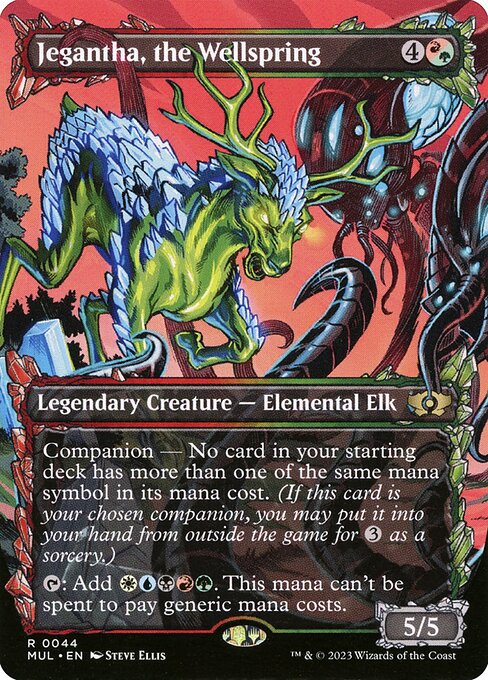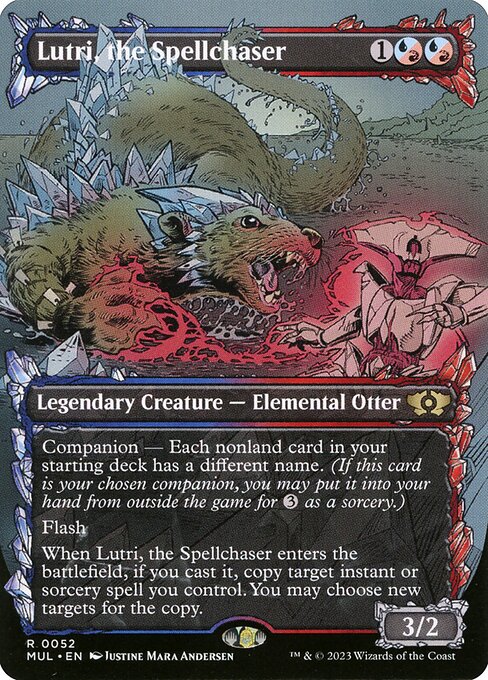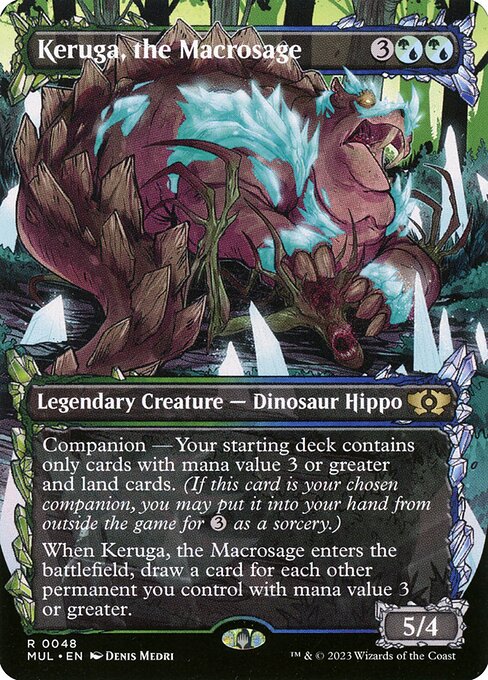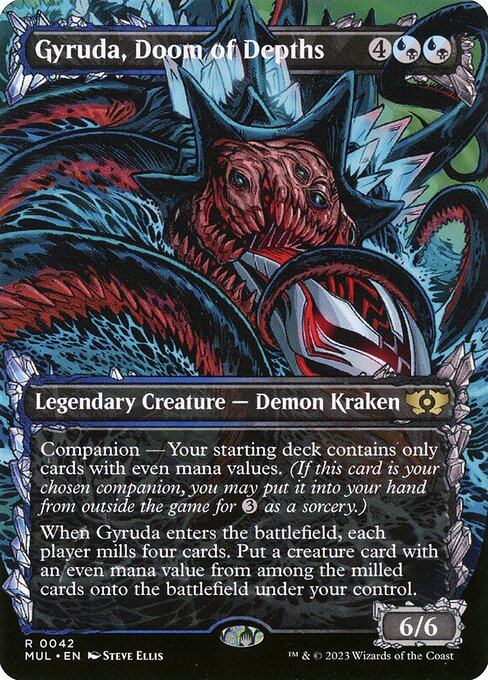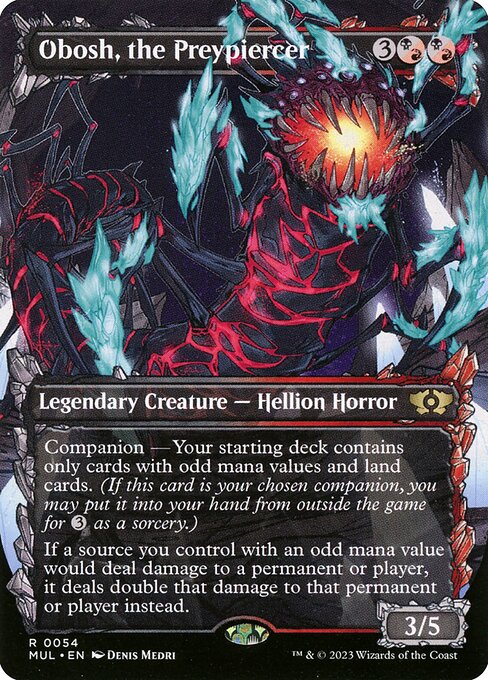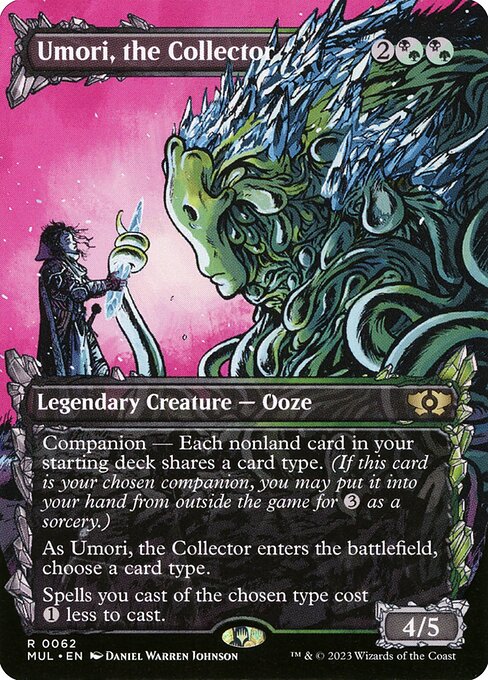Table of Contents
MTG Arena is bringing back past Premier Draft events while Jumpstart is delayed to keep players occupied, and Ikoria: Lair of Behemoths will be the final one to wrap up the series from August 20 to August 26! Here is our in-depth guide to the format so you can get the most out of your free entry.
Hello again everybody, I hope you are doing well. First, I will be discussing the format as a whole, then going over some strategy for getting the most out of its mechanics and various synergies.
After that we will take a look at some general archetypes of the format and the key cards for enabling them. Ikoria is quite a lot different than recent sets, primarily because mana fixing is incredibly abundant which allows for a plethora of color combinations and deck types.
Where in the past I would go over the ten 2-color archetypes, that is not sensible this time around. Instead I will be focusing on deck structure and how to choose cards that work best together, rather than simply selecting all of the highest rated cards according to some Tier List and jamming them into one deck.
Just because it is possible to play multicolor ‘good stuff’ decks doesn’t mean they are going to automatically be great. Finding the right balance in your deck composition is harder than ever in this set, but I am here to help. For more reading, check out more Ikoria limited strategies here.
The Format
Ikoria: Lair of Behemoths is basically a Core Set on steroids. Sure, the Mutate and Companion mechanics along with the return of Cycling add complexity beyond what you would find in a Core Set, but bear with me on this point. What got me thinking about this was noticing many Core Set staples showing up in Ikoria. Cards like Pacifism, Anticipate, Frost Lynx, Bristling Boar, etc.. Then it dawned on me how many of the new cards are upgraded Core Set spells.
Blood Curdle is Eviscerate except at instant speed and comes with a Menace token. Of One Mind is Divination with a 2 mana discount at times. Ram Through is Rabid Bite except at instant speed and provides Trample damage, and the list goes on. While this can be said for any set to some extent, it seems particularly true for IKO. Core Sets also tend to feature ‘Timmy bait’ which are often large creatures, and the Godzillas are the epitome of that. But most striking of all is the prominence of abilities at the core of this set:

The allied color abilities are on full display in Ikoria, and will end up comprising a sub-theme for many of your decks. The chart above should be committed to memory as it can help you make tough decisions about which colors to move in to based on your early picks. It isn’t all-encompassing though, as Black features Lifelink with Duskfang Mentor as well as a little Deathtouch, Red has some First Strike, Green has Reach, Blue has Hexproof, etc. Speaking of the Mentor cycle:
These spells are the best non-rare ability payoffs and are worth prioritizing in Draft. Unless your deck is a distinct archetype like Cycling or Humans (more on those later), your deck will likely have enough non-Humans to justify playing these even without any other spells that share their ability. Recurring +1/+1 counters, while slow, put a lot of pressure on your opponent to start racing you or use a precious removal spell before things snowball.
This is the type of format that heavily rewards being patient with removal, so baiting your opponent into using it on your 3-mana Mentor is a good place to be. When playing against these I would advise you to only remove them if there are multiple creatures with the relevant ability on their board. If they want to spend turns placing counters on one creature let them, then remove that creature when it gets out of hand.
Finally, respect the ability during combat; I’ve caught a surprising number of opponents by surprise when adding a counter as a combat trick. That is going to settle down as people get more familiar with the set, but even if both players are aware of the ability, it can still be held up to improve attacks.
Here is a deck I drafted recently that featured some mentors:

This deck actually got me to Mythic this season. The overall plan was to win via card advantage and tempo, and the three mentors provided some nice opportunity for synergy. Unexpected Fangs, for example, is not a very good combat trick. But with two Duskfang Mentor in the deck it became a solid enabler. You can also see how this build balances humans/nonhumans to reliably enable its four powerful mutate creatures as well as allow Of One Mind to cost a single mana much of the time.
I will be showing off some more powerful decks later, but this is a good example of a draft where no decent rares (or hard removal) made an appearance, forcing me to be scrappier and get the most out of card synergy. Ultimately these abilities end up being sub-themes in most decks rather than archetype-defining, so let’s move on to the mechanics that are going to make or break your Drafts.
Companions
I tend to focus on common and uncommon cards in these reviews since they are the most prevalent, but the Companions are so impactful in this set that they are well worth discussing here. Nearly all of the 10 Companions can be considered Bombs in this set, so you should be excited to open them or have them passed to you. It isn’t really possible to rank them since their value is so dependant on which pack you see them in.
They are at their most exciting when you get one p1p1 and are able to build around it effectively. Starting every game with a free eighth card is a tremendous advantage, but some ask for a significant sacrifice as tribute before you are allowed to Companion them. So, opening Gyruda, Doom of Depths pack 3 for example is unlikely to result in it being your companion, but it will still make a great addition to your deck as long as you are in Black or Blue at that point. To take a closer look at the Companions I am going to break them into a few groups:
Easy to Companion, but limited upside
These two are relatively easy to Companion even if you get them late. Jegantha is basically a vanilla 5/5 for 5, which at first glance isn’t too exciting, but I can’t stress enough how good having a free 8th card is. Lutri, the Spellchaser is even better in a lot of cases, although in some drafts it won’t be worth sacrificing too many important cards to Companion it. There are many good spells to easily copy including Of One Mind and Fire Prophecy as common examples. Subsequent Companions have flashier abilities, but their requirements are more difficult to satisfy. In this way they seem (mostly) balanced with one another.
I think Lutri is actually pretty incredible; you know
Worth making your Companion if you find them early enough
Keruga, the Macrosage is somewhat risky, as you forego 2-drops. At this point the meta is slow enough to justify the incredible card advantage but that could very well change. I would still love to have any of these cards in my deck, Companion or not, so it is important to consider the cost/benefit to Companion. I placed these three in this category though because if I got them p1p1 I would for sure build around them.
For example, here is a Gyruda deck I put together recently:

This one is not as clean as I would have liked, but playing only evens is tough. It ended up going 2-1 in Traditional Draft, falling just short in the third game of my last match. Notice I used some Mutate creatures to fill in my curve and sort of ‘cheat’ the downside.

My recent Yorion deck performed even better, convincingly going 7-1 in Premier Draft. 60 card decks are always going to be a mish-mash of mechanics and synergy, but having cards like Savai Thundermane, Wingspan Mentor, and Sanctuary Lockdown along with enough Cycling, Flying (Helica Glider was nice in this deck), and Humans to support them worked out really well. Having a free 4/5 flyer every game was well worth any clunkiness, and the cycling and card advantage in here helped smooth things out.
Difficult to Companion but it can work
It takes significant effort to build around these. Most of the time it probably won’t be worth it because they are still good cards in your deck as long as you partially build around them. That said, it is really scary going against these Companions if you have no hard removal. These are the type of decks that laugh at your Pacifism and Capture Sphere spells, but absolutely crumble if the Companion gets hit with a Blood Curdle. For me the risk/reward just isn’t there, but I have seen some really cool decks that feature these three.
Don’t try to Companion, but still play!
I have yet to lose to an Umori deck and think it is a trap. Obviously you have to pick Creatures in Limited, which means you won’t have any removal. Removal is just too important in this format for Umori to be worth it. I still don’t think it is impossible to end up with a good Umori deck (likely Mutate oriented), but wouldn’t advise attempting it. Zirda is basically impossible to Companion, but is a nice addition to the RW Cycling deck (which I promise we will get to soon)!
Mutate
Mutate is a very interesting mechanic that opens up a world of possibilities and difficult choices when it comes to drafting, deckbuilding, and deciding on lines of play. Since only non-Humans can serve as Mutate targets, you have to be sure to balance your ratio of Human/Non-Human/Mutate Creatures. Generally you will want to limit your deck to a handful of Mutate creatures and have a few more than that in terms of Mutate targets. Casting Mutate creatures normally is painful and needs to be avoided as much as possible.
These three are the most important Mutate commons. All of them mitigate the downside inherent in gluing two of your cards together, and their abilities are strong enough to justify piling on additional Mutate creatures at times. This is one of the most important decisions to make in Ikoria, though.
Stacking two Dreamtail Heron on top of each other does trigger both, but you’ve essentially just spent four mana to cast Of One Mind. Adding another will draw you three additional cards, but now you’ve piled up three of your better threats. So, it is really important that you have enough stuff to find with all that card draw to win you the game if your 3-headed Heron is removed. It is an extreme example but it helps illustrate what to consider when playing these spells.
The equation can change pretty quickly, though. Turning Cavern Whisperer into Mind Rot could be a great play if your opponent is holding two cards and your board situation is decent. Maybe you really need to find another land with Migratory Greathorn to play an important spell. There are also creatures that can provide additional bonuses for using Mutate (often on the same creature):
Essence Symbiote is an extremely good payoff at common. Notice it doesn’t have to Mutate itself to provide benefit, which is a surprisingly huge bonus. In practice I have found that creating multiple mutated creatures is often better than piling them all up into one stack. Symbiote can put on significant pressure with an early mutation into something like Vulpikeet, and provide additional value as you build up your second threat.
Pollywog Symbiote has been going later than I would expect and is better than a lot of people think. Getting Dreamtail Heron on the board turn three and coming out ahead even if your opponent has some way to remove it is kind of nuts.
Zagoth Mamba is the worst of the three, but the Dead Weight effect can take out some relatively important creatures or cause your opponent to respect it post combat in some situations.
Mutate can get really out of hand when you are able to score some of the key uncommon (or even rare) spells:
As you may have guessed, Green, Black, and Blue are the best colors for Mutate. White and Red have some decent options though:
All of these cards are solid in the right deck. Porcuparrot can be an interesting build around and gets quite obnoxious with Deathtouch or multiple mutations. But, generally for these colors the mechanic of choice is Cycling.
Cycling
In my Set Review written before release, several of my ratings came with the disclaimer ‘this will likely change based on how good Cycling ends up being.’ Well, it looks like many of those cards are going to be moving up on the Tier List because Cycling decks are the real deal. The perfect formula for these decks is still getting figured out, but here are some of the key guidelines:
12-14 Lands
This may seem like a really low range, but Cycling thins the deck so quickly that the primary risk of playing this archetype is getting flooded. I suspect the ‘hand-smoothing’ getting fixed in Premier Draft actually hurts this archetype because you ideally want to begin each game with 2 lands in hand, not 3-4. Running so few lands means that you need to find a lot of playables during the draft, but fortunately there are many options for filling out your deck:
Go for Blood is the best option of the three, but all become playable in this deck. Shredded Sails in particular goes really late in the draft and at worst it is another Cycle effect but sometimes you get lucky and can blow up a Dreamtail Heron or Crystalline Giant out of nowhere. You can also scoop up Cycling (1) cards that are outside of your colors like Frostveil Ambush late in the draft to fill out the deck. So what are the payoffs for loading up on all of these Cycling cards?
Important Payoff Creatures
Snare Tactician may be the single most important card for this deck. Your main source of damage is getting through with these smaller creatures, and having the ability to tap down multiple blockers without losing card advantage is crucial. Drannith Stinger is also important to get multiple copies of, as the consistent pings help get your opponent down to lethal range for a big Zenith Flare later in the game. All of these spells are efficient, further your game plan, and should comprise the lion’s share of creatures in your deck.
Noncreature Payoffs
Yeah, Zenith Flare ends up being a lot better than I had predicted and is the primary win condition for this archetype. It isn’t too unusual to get X as high as ten. Sometimes it ends up rotting in your hand because you need more cards in your graveyard to reach lethal, but the upside is tremendous.
Cards like Reptilian Reflection go a long way to helping get your opponent into that lethal zone. The Enchantment gets through pretty easily with the help of Snare Tactician or
This seems good, should I force it?
Just how good this archetype is remains to be seen because there are a few factors at play. Early in a format decks tend to be more durdly which buys precious time for a deck like this to go off. Cycling also tends to be very weak against any sort of life gain. This deck can reach 20 damage much more easily than I expected, but pushing even a handful past that tends to be quite difficult.
There is also potential for this archetype getting crowded in drafts. If it turns out that Cycling is far and away the best deck and a lot of people begin forcing it, there likely won’t be enough payoffs to go around. In addition to human drafts being more fun, they also integrate supply and demand more organically which helps even out the power level of archetypes.
To be honest I find myself rooting against this one. Ikoria Limited is a pretty fun environment with tons of interesting combinations of cards possible due to all of the mana fixing. If a distinct archetype like this ends up being overpowered it has the potential to ruin the format in my opinion. Don’t get me wrong, I do appreciate how interesting the Cycling deck is and how fun it is to play, I just get bored when sets become defined by 1-2 overpowered archetypes. Time will tell with this one.
Humans
The only other homogenous archetype is the good old fashioned Homo Sapiens. It would seem like Humans would be at a severe disadvantage against giant mutated beasts and Godzillas, and they largely are. But the Mutate mechanic does leave many decks susceptible to ‘go-wide’ strategies, and that is what Humans bring to this format:
Oh, did I mention that many Humans will need to die in order to conquer the monsters? Can’t make an omelette without breaking a few eggs, I suppose. Weaponize the Humans, more like. I do think the archetype works best as a BR thing, but playing White or even going full Mardu is fine too.
Important Creatures
Besides General’s Enforcer (which is a great reason to be in White), all of these creatures are pretty easy to come by and set up a fairly Aggro curve. Bushmeat Poacher lowers your tempo, but especially in conjunction with Bastion of Remembrance she is a powerful engine. The game plan is to flood the board early and often and do enough early on to set up a reach damage or go-wide finish. Probably the most attractive aspect of playing this archetype is it adds a lot of value to lesser-played cards.
Mutual Destruction in particular is a great removal spell in this deck that you are likely to acquire as a very late pick. Dire Tactics goes a bit earlier but also gets passed a lot in this format. Oh, Whisper Squad… I am pretty sure I gave this card an F in the Set Review. It is still a bad card and shouldn’t be higher than a D.
Nonetheless, if any archetype can make use of a handful of one mana 1/1’s it is this one. Keep in mind that this archetype gives up access to good stuff like mentors and Mutate creatures, so sometimes it will be best to construct a hybrid deck that features some Human synergy while still incorporating several non-Humans in order to play those cards.
Here is my most recent draft, which happens to be Humans:

I borrowed a little Cycling synergy which allowed me to cut lands pretty low. With the two Splendor Mare and filler two drops I was able to justify Cavern Whisperer. Other than that, this is a Humans deck all the way. I happened to pick up the General Kudro of Drannith as well as his Enforcer, which is really cool. Bastion of Remembrance and Sanctuary Lockdown also get to work in tandem here. Additionally, Daysquad Marshal and Nightsquad Commando team up to enable all of these Human payoffs.
Game 1, Match 3 ended like this:

Match 2, Game 1 I got to really flex

Hopefully this thing can secure the 3-0 when I finish up later.
Other Archetypes, Deck Composition
From here, archetypes start becoming hybridized and difficult to pin down. The most important thing is to prioritize Removal and a good curve. From there you can get creative with building synergy, but be sure to construct a viable mana base alongside it. Maybe it would be best if we begin by looking at a couple examples from decks I drafted this past week:

Chevill, Bane of Monsters was the best card in this deck, generating insane value (often via Ram Through). This one ended up a little short on 3-drops, but there were still quite a few things to do 3rd turn. Migratory Greathorn mutates on turn three, I could Remove something, or even cycle a Greater Sandwurm or
I would have loved to have Lore Drakkis in this deck to recur Back for More (or other removal), a combo I was able to pull off a couple times in another deck. One of the essential skills in drafting hodgepodge decks lies in creating space for your worst cards to overperform. Cloudpiercer, for example, is only an okay Mutate creature. But with great targets like Essence Symbiote, Fertilid, Glowstone Recluse, and Farfinder it became a key threat.
Mythos of Brokkos won’t make the cut in a lot of decks but I had the capacity to splash an Island for the tutor component and effectively double my chances of getting Chevill, Bane of Monsters on the battlefield.
Fully Grown is an awkward 41st card, but it did pay off when opponents had to stack block in an attempt to take down my Cloudpiercer or Greater Sandwurm and got run over. This deck had a lot going for it and ended up going 3-0 in Traditional Draft.

This deck had a lot of cute plays such as Pollywog Symbiote or Thieving Otter into Dreamtail Heron (Mutate), or Parcelbeast mutated on top of Glimmerbell. Having access to good rares like Lavabrink Venturer and Gemrazer was nice, but the thing is you will pretty much always end up with good rares drafting decks like this because they are what pulled you into your colors in the first place.
Most 3-4 color decks are going to feature Green, simply because it gives you access to Humble Naturalist, Fertilid, and Migratory Greathorn. If I had found some Black or Red bombs in this draft I certainly would have been able to play them. Even splashing for Blood Curdle would have been great, as Removal can be difficult to find in Bant colors. While always important, it is imperative to be patient with your Removal spells when playing a deck like this with so few of them.
Ultimately, creating a good curve and making sure every card has an important role to play in your deck can help offset drafts that don’t pan out as well as you had hoped. In spite of its flaws this deck was able to earn a 6-3.
Conclusions
Ikoria: Lair of Behemoths is a really cool set, and I have thoroughly enjoyed drafting it. I would like to leave you with a few key takeaways that I have surmised over my time with it so far:
- There are surprisingly few Bombs – Ignoring the companions, there are not very many cards that completely take over the game, especially in individual colors (Vivien, Monsters’ Advocate is absolutely oppressive, though). The best cards tend to be multicolor, which provides terrific incentive to splash colors.
- The Fixing is excellent – ‘Good Stuff’ decks are here to stay and it has been a compelling change of pace compared to other recent formats. Green is the path of least resistance, but the tap lands and artifacts provide alternate routes.
- The Removal and Creatures are Strong – Ikoria is a super-powered set but it balances out pretty nicely. The bigger they are, the harder they fall.
- The Cycling deck is very good – Whether or not it completely takes over the format is anyone’s guess at this point, but it is well worth drafting if open.
- The Speed of the set remains to be seen. Personally I think Ikoria will mimic Eldraine which was fairly durdly at first but once a cohesive Aggro deck was ironed out the pace quickened. There are a lot of great 2-drops and ways to curve out in Ikoria, which should make for a fast format. However, the Mutate mechanic and multicolor environment work to slow things down at the same time. It will be interesting to see where we reach an equilibrium in the coming weeks.
For reference, here is my article that details my rationale to changes I have made to the Tier List since the set release. Farewell for now!
Premium >
Enjoy our content? Wish to support our work? Join our Premium community, get access to exclusive content, remove all advertisements, and more!
- No ads: Browse the entire website ad-free, both display and video.
- Exclusive Content: Instant access to all exclusive articles only for Premium members, at your fingertips.
- Support: All your contributions get directly reinvested into the website to increase your viewing experience!
- Discord: Join our Discord server, claim your Premium role and gain access to exclusive channels where you can learn in real time!
- Special offer: For a limited time, use coupon code L95WR9JOWV to get 50% off the Annual plan!
































